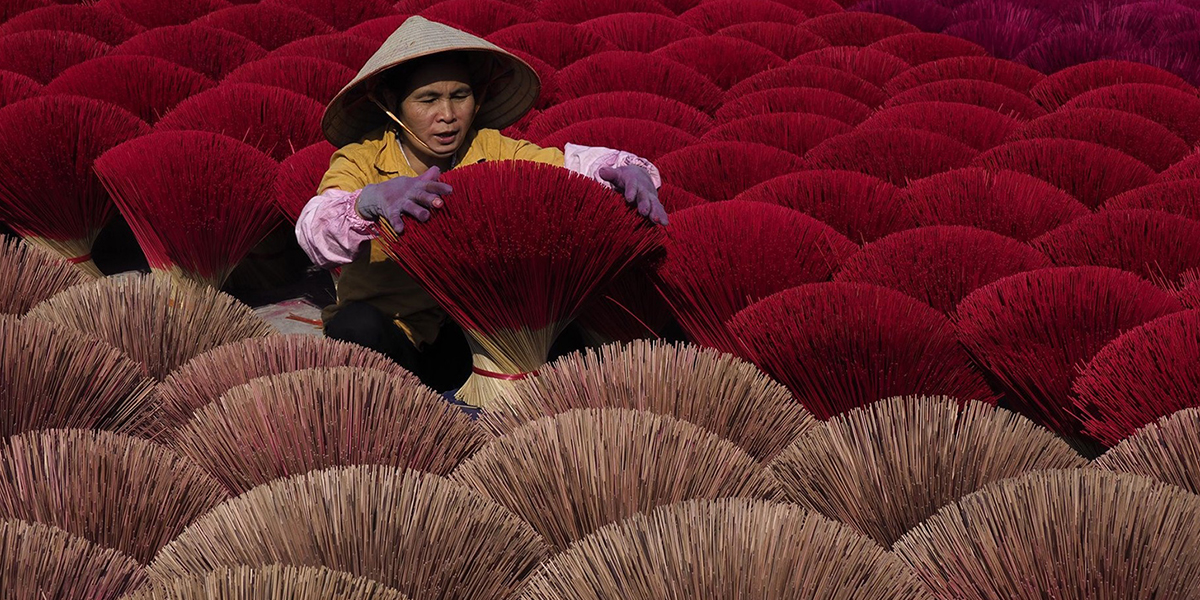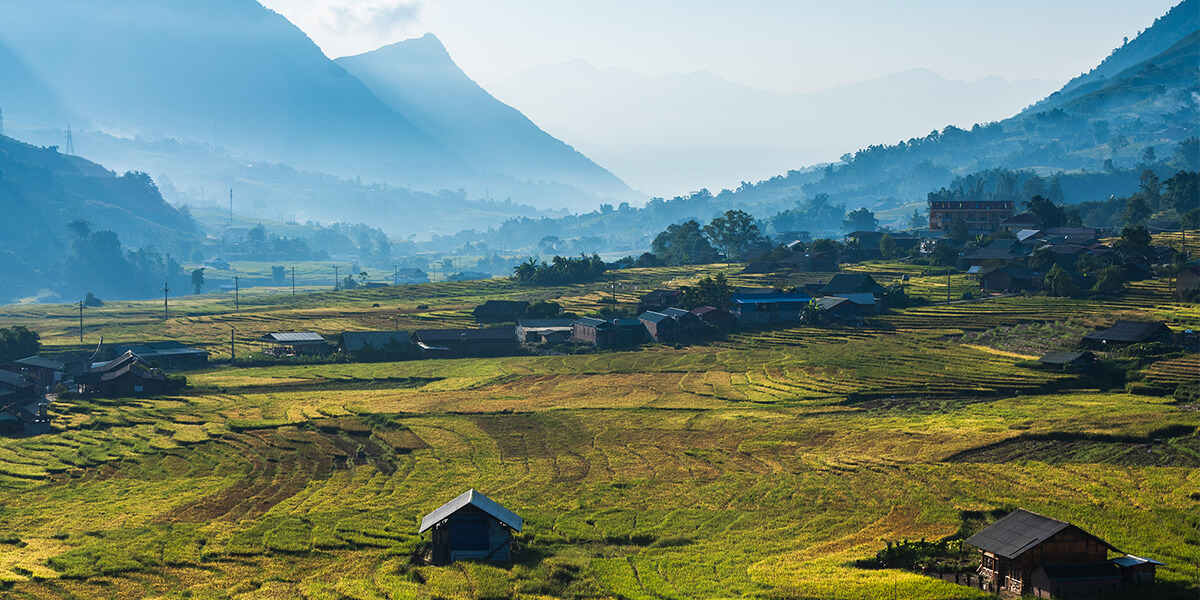Vietnam has experienced several periods of prolonged warfare, as a result, its capital has been formed and relocated multiple times. Each capital in different periods of time captures a distinguishing feature of Vietnam in the corresponding context.
I - Hanoi - the current capital of Vietnam country
1 - One of the ancient capitals in the world
Located on the banks of the romantic Red River, with a history of more than 1000 years, Hanoi city has always been the center of Vietnam's culture, economics, and politics. In 1010, this land was chosen to build a new capital with the name “Thang Long” by King Ly Thai To, the first emperor of the Ly Dynasty. From 1831, under King Minh Mang, Thang Long began to bear the name Hanoi.

Hanoi - the capital of Vietnam in the 20th century - Source: Kienviet
Hanoi, rebuilt and re-planned by the French, once again became the capital of the Indochinese Federation in 1902. Hanoi was the capital of the Democratic Republic of Vietnam during the Vietnam War and continued to be the capital of the present Socialist Republic of Vietnam in 1976. Later in 1999, Hanoi was announced “The City of Peace” by UNESCO and chosen to be the host of the “International Peace Year - 2000”.
2 - Hanoi - the capital of Vietnam has dramatically changed in recent years
Taking advantage of new global opportunities, Hanoi capital is striving to bring into the international arena to its internal strength. Hanoi had been established and developed for a long time and as a result, it has become a city with great tourism potential. The land possesses various historical relics such as the Temple of Literature, Thang Long Citadel, One-Pillar Pagoda, Hanoi Old Quarter... Along with architectural works, other interesting things that might amaze tourists are Hanoi’s food and street shop system. There are also various forms of entertainment such as amusement parks, walking streets, night markets...

A corner of Hoan Kiem lake in Hanoi - Source: Baotintuc
The capital of Vietnam is also ranked as the world's top safe destination. Here you can always experience things without concerns since Vietnam's politics is relatively stable and mostly there are no encounters or protests. The local life is always bustling, offering a variety of entertainment since this city is a key economic region and is well invested in all fields, from transport, infrastructure, hospitals, schools, services,...
In short, if you have a big interest in learning about the history and culture of Vietnam, Hanoi might be a must-see destination in your bucket list.
II - Capitals of Vietnam during the 20th century
The involvement of French colonizers in Vietnam since 1858 had forcefully disrupted the social order in Vietnam. They divided the country into two parts, which are the Northern and the Southern, to help them effectively manage their administrative ownership. This situation lasted until 1975 when Vietnam finally got rid of the Americans and reunified the country.

Hanoi in the French colonial period - Source: Mof.gov
1 - Hanoi - the capital of North Vietnam
After Ho Chi Minh proclaimed the independence of Vietnam in 1945, the French returned and reoccupied the city in 1946. After nine years of fighting between the French and Viet Minh forces, Hanoi became the capital of an independent North Vietnam. In 1954, The Democratic Republic of Vietnam and France signed an Agreement on the military transfer of Hanoi and an Agreement on the administrative transfer of Hanoi.
As the base of the new government, the capital of North Vietnam, Hanoi was many times the target of the enemy, suffering direct attacks from the United States. During the fight for the independence of the country, in 1972 the most intense battle "Hanoi 12 days and nights" occurred. On April 30, 1975, when the country was completely liberated, Hanoi stepped into the work of economic construction, restoration and development.
Hanoi was once considered the capital of French Indochina, so it still has old-world charm and heritage. You can find a lot of French-influenced architecture there such as French colonial villas and mansions, Hanoi Opera House, Presidential Palace, Saint Joseph Cathedral...
2 - Ho Chi Minh city - the capital of South Vietnam
Ho Chi Minh City, widely known as Saigon - the financial center of Vietnam, was the US base during the Vietnam War in the 20th century. This city has gone through a number of political changes including being conquered by the French and Spanish, becoming the capital of the anti-communist independent republic of South Vietnam, then finally reunited with the North and being renamed Ho Chi Minh City in honor of the country leader.

Ho Chi Minh city or Saigon was the capital of South Vietnam - Source: Thanh Binh
Saigon has been the capital of the Autonomous Republic of Cochinchina since 1946, until 1949 when former Emperor Bao Đai as head of state made Saigon the capital of the State of Vietnam. In 1954, the Geneva Agreement partitioned Vietnam along the 17th parallel (Ben Hai River), with the communist Viet Minh under Ho Chi Minh, gaining complete control of the northern half of the country, while the southern half gained independence from France. After Bao Dai was deposed by Prime Minister Ngo Dinh Diem in a referendum in 1955, the Republic of Vietnam was established and Saigon was chosen as the capital of South Vietnam. For years, communist forces launched several attempts to retake the city and finally, on 30 April 1975, Saigon fell, ending its 29 years of being capital as well as the Defense War.
If you are eager to learn about the history of Vietnam, especially during the Wars, Saigon is the place you can see a lot of war-era museums and relics such as the Ho Chi Minh City Museum, the Revolutionary Museum, the Museum of Southeastern Armed Forces, the War Remnants Museum, and the hauntingly evocative Cu Chi Tunnels, used by guerilla fighters.
III - List of the old capital of Vietnam during the feudal period
1 - Phong Chau

Hung Vuong ara - Source: Hoatuy
- Dynasty: Hong Bang - Hung Vuong (2524 – 258 BC)
- Current location: Phu Tho Province
According to legend, the site was where Au Co, wife of King Lac Long Quan, gave birth to their children (ancestors of the Vietnamese).
2 - Co Loa - one of the oldest capitals of Vietnam
- Dynasty: Thuc dynasty (257 – 208 BC) & Ngo dynasty (939 – 967 BC)
- Current location: Dong Anh District, Hanoi
Co Loa citadel is an important archaeological site in present-day Hanoi's Dong Anh district, with various relics of the Bronze Age Phung Nguyen culture, Dong Son culture, and the unique construction made of multi-layered structures of earthworks, moats, and ditches.
3 - Me Linh - the capital of Vietnam before Hanoi
- Dynasty: Trung Vuong (40 – 43)
- Current location: Me Linh District, Hanoi
The hometown of two heroines called the Trung sisters, who led the first national uprising against their Chinese conquerors in 40 AD. As a result, several temples commemorate the two sisters.
4 - Long Bien
- Dynasty: Early Ly dynasty (544 – 602)
- Current location: Long Bien District, Hanoi
After Ly Bi's successful revolt in 544, it served not only as of the capital of Van Xuan but also as a trading port in the late 8th and early 9th centuries. There are still some historical controversies surrounding this capital.
5 - Hoa Lu - one of the first feudal capitals of Vietnam
- Dynasty: Dinh dynasty (968 – 980) & Early Le dynasty (980 – 1009) & Later Ly dynasty (1009 – 1010)
- Current location: Ninh Binh province
Hoa Lu ancient capital is a particularly important national relic complex of Vietnam and one of the four core areas of the Trang An world heritage complex recognized by UNESCO. In the late 10th century, Hoa Lu served as not only the capital but also the economic, political and cultural center of the first two imperial dynasties of Vietnam: the Dinh, and the Early Le. Hoa Lu Ancient Capital Historic Site now has a planned area of 13.87 km² in Ninh Binh province, which is a place to store historical relics over the ages.
6 - Thang Long - old capital of Vietnam
- Dynasty: Later Ly dynasty (1010 – 1225) & Tran dynasty (1226 – 1440)
- Current location: Imperial Citadel of Thang Long, Hanoi
After ascending the throne, King Ly Thai To, established the Ly Dynasty, moved the capital to Dai La Citadel (Hanoi) and renamed it Thang Long (Rising Dragon). Inheriting the Ly Dynasty, the Tran Dynasty also built several structures such as Feng Shui Palace, the Temple of Literature,... Some of them are preserved as historic and cultural relics up to now which allow travelers to pay a visit.
This capital city of Vietnam is a massive architectural work, built by kings in many historical periods and has become one of the most important monuments in the system of Vietnamese monuments. On August 1, 2010, the World Heritage Committee (WHC) of the United Nations Educational, Scientific and Cultural Organization (UNESCO) recognized the central area of the Imperial Citadel Thang Long - Hanoi is a world cultural heritage. The outstanding global values of this heritage site are recognized by three outstanding features: 13 centuries of cultural history; continuity of heritage as a center of power; and the layers of relics are diverse, rich and lively.
7 - Tay Do - Vietnam's capital under Ho dynasty
- Dynasty: Ho dynasty (1400 – 1407)
- Current location: Vinh Loc district, Thanh Hoa province
The Citadel of the Ho Dynasty was built in a short time, only about 3 months (from January to March 1397), with unique large-scale stone architecture in Thanh Hoa. So far, although it has existed for more than 6 centuries, some sections of this citadel are still relatively intact, including its gates, and were inscribed on UNESCO World Heritage Sites in 2011.
8 - Dong Kinh
- Dynasty: Later Le Dynasty - Le So Dynasty (1428 – 1527) & Early period Mac Dynasty (1527 – 1592) & Later Le Dynasty – Le Trung Hung (1597 – 1789) & Lord Trinh (1597 – 1787)
- Current location: Hanoi
9 - Phu Xuan - one of the capitals of Vietnam
- Dynasty: Nguyen lords (1678 – 1777) & Tay Son dynasty (1786 – 1802)
- Current location: Hue city, Thua Thien - Hue province
Phu Xuan was chosen by Nguyen lords to serve as their family seat and later officially became the capital of South Vietnam when Nguyen lord - Nguyen Phuc Khoat proclaimed himself Vo Vuong (Vo King or Martial King in Vietnamese) in 1744. In 1786, Phu Xuan became the Tay Son Dynasty capital under the reign of Emperor Quang Trung. In June 1789, Nguyen Anh took the throne of a unified Vietnam and proclaimed the ancestral seat of the Nguyen Lords.
10 - Hue - the last feudal capital of Vietnam
- Dynasty: Nguyen Dynasty (1802 – 1945)
- Current location: Hue City, Thua Thien - Hue Province
Hue Citadel is an ancient capital, being the Nguyen Dynasty's capital for 143 years from 1802 to 1945, belongs to four wards Dong Ba, Tay Loc, Thuan Hoa, and Thuan Loc of Hue city. The Citadel was surveyed by King Gia Long in 1803, started construction in 1805, and was completed in 1832 under the reign of King Minh Mang. Currently, Hue Citadel is one of the relics belonging to the Complex Hue Monuments Complex, recognized by UNESCO as a World Cultural Heritage.
The capital of Vietnam at any time in the flow of history always play an important role in the history of Vietnam and the development of the country.
People also asked:
1 - What is the capital of Vietnam today?
→ Hanoi is the current capital of Vietnam
2 - What was the capital of South Vietnam?
→ Saigon was the capital of South Vietnam
3 - What was the capital of North Vietnam?
→ Hanoi was the capital of Vietnam
4 - The capital of Vietnam is Ho Chi Minh city?
→ No, it is not. Ho Chi Minh city is well-known as the largest city in Vietnam, and Hanoi is the only capital of Vietnam.
5 - Is Phnom Penh or Hanoi the capital of Vietnam?
→ It is clear that Phnom Pend is the capital of Cambodia, and Hanoi is the capital of Vietnam.







 — Quan Nguyen
— Quan Nguyen





































